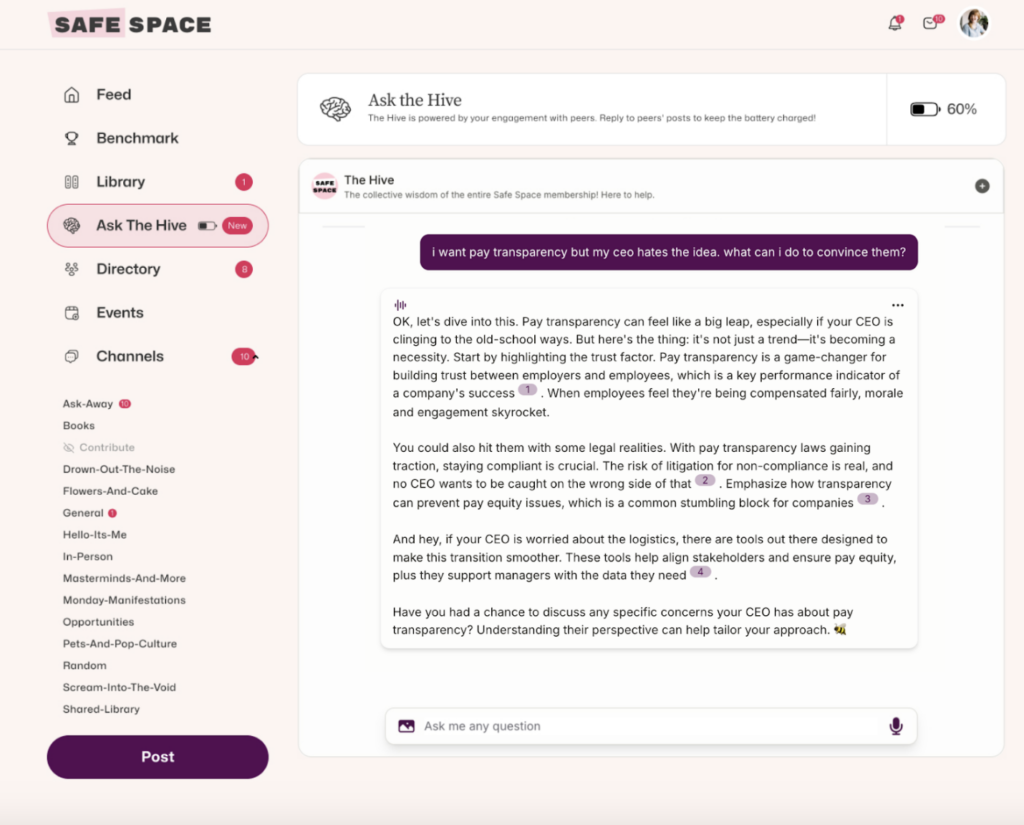
What do you do when the HR Director cannot be trusted? She never maintains confidence and reports everything to the CFO.
Context: Mid-size multi specialty healthcare practice.
Marcie Chavez, Senior HR Manager at Amy Porterfield, Inc.:
It’s a tough situation when an HR leader you work with (or for) develops a reputation for lacking discretion and confidentiality. In my opinion, this is where “Radical Candor” or direct feedback could come in handy, if you (or another employee in your organization) feels safe enough to deliver the feedback directly to this person.
Using the SBI Model you would set up time to discuss with the HR Director one-on-one the concern.
S – Situation:
“In our industry and function, both healthcare and HR, maintaining confidentiality is crucial for building trust and ensuring sensitive information is handled appropriately.”
B – Behavior:
“I have observed that you have shared some confidential matters with the CFO, that I don’t believe should be shared. (give a clear example and why you did not see a need to share)”
I- Impact:
“Sharing confidential things with the CFO when they don’t have a need-to-know leads to a breakdown of trust between employees and the HR department. Employees may become reluctant to share concerns or issues. I realize that I may not have all of the context on why the information was shared, so I would also like the opportunity to understand more about the reasons for the behavior, while simultaneously sharing this candid feedback and concern with you directly in an effort to maintain open and honest feedback.”
Providing the feedback directly and privately allows the person to save face (rather than going straight to their boss, who quite possibly is the CFO in this example.)
If you don’t have the ability to deliver that feedback directly, it may be good to share that with someone else with authority to address the situation with the HR Director.
In situations like these, I’ve also seen concerns come from employees in exit interview feedback, anonymous pulse surveys or engagement surveys, or even compliance hotline reporting mechanisms. If you have other reports of the feedback, not just your own observations, that could help to bring forward to the Director to demonstrate the issues at hand (or to their direct leader).
Sondra Norris, OD/OE Consulting:
Never, always, and everything are severe words – is that truly the case is my first question.
JOIN 150K+ HR LEADERS
Get insights, learnings, and advice on how to build companies and cultures that people actually love.
No spam. Unsubscribe any time.
Second question is to strive to understand why HR Director is sharing information:
– Is CFO the boss?
– Has CFO demanded this?
– Does HR Director feel under-qualified (or is under-qualified) to take full responsibility and accountability for decisions and actions? [Is it safer for her to have “someone else in on the decision?”]
– Has it ever been explained why much of what HR deals with is confidential and could present a liability to the company?
– Is there clear role definition and separation?
I would think that answering these questions would lead to an answer.

What do you do when leadership says they’re open to feedback, but doesn’t change their behavior?
Context: CEO has exhibited “mean girl” behavior. It seems like no matter who is giving the feedback (co-leaders, direct reports) and no matter how direct the feedback is, it always falls on deaf ears. Any advice?
Sondra Norris, OD/OE Consulting:
What a challenge rife with complexity!
First of all, compassion. CEO is almost by definition a lonely role. People are not typically honest and forthcoming, there is too much at stake – so who to believe about what? Add female to that mix and it’s more complicated by all the prevailing beliefs and preconceived notions about “what it takes” to be “successful.” Does she show up hardened and stoic to prove she’s got things under control and isn’t a “weak female?”
Underneath all of that is what’s happening inside the individual that is driving the behavior, consciously or subconsciously.
Feedback is a landmine here.
If the person doesn’t acknowledge their contribution, their difficulty moving forward, and that it’s their problem to solve (with help), coaching is a losing proposition.
Depending on how long she has been behaving this way, showing up publicly this way will be a big contributor to her willingness and ability to show up any other way – that’s a big admission for anyone to make, especially from the seat of CEO.
Suggestions that can be attempted “from below” (compared to “from above” = The Board):
1. Data Set #1. This can be collected from the Leadership Team about the CEO and about how they function as a team. Quantitative and Qualitative, and collected by someone outside the company. This can also include data from the whole company, segregated demographically and organizationally. Share this privately with the CEO and make the connections between their conduct and the effects.
2. Data Set #2. Company performance. Business metrics and others like: retention, turnover, customer retention, number of chronically unaddressed business obstacles.
3. Some education on what makes healthy and committed human relationships possible: Both parties need to feel protected, safe, a strong sense of belonging, free from judgment, free from the need to “mask” or censor themselves for fear of being labeled a pariah.
4. Start building trust on the team. Simple conversations, like suggested by Lencioni: sharing personal histories. Tell us about your family. How many siblings. Where are you in the birth order? What was the most interesting or difficult challenge you faced as a child? This is not only a level-setting conversation, but starts to tap into shared emotional experiences, starts to open up vulnerability and creates room for trust. And this starts to create the sense of the leadership team as a protecting group of people – which will help decrease risk the CEO feels. Have them do this together. There are many layers of trust to start building here – between and amongst team members.
5. Create a set of agreements/promises/commitments across the team – This is who we want to be as this company’s leadership team; these are the things important to us; these are the ways we will conduct ourselves. Facilitated longer-term process to keep them moving towards better.
Another way … is to confront with performance data, cite her behavior as causal, and expect improvement. This would have to come from The Board, though. And doesn’t usually go too well.
No easy answers. No shortcuts.
AnnE Diemer, HR Consultant:
1) Ug. GTFO.2) Check out Civility Partners and see if they can help? What I’ve learned from them is that demonstrating the impact of the negative behavior is key to helping someone really hear you and make change.


